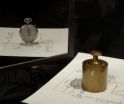(Press-News.org) CAMBRIDGE, MA -- MIT engineers have created a new polymer film that can generate electricity by drawing on a ubiquitous source: water vapor.
The new material changes its shape after absorbing tiny amounts of evaporated water, allowing it to repeatedly curl up and down. Harnessing this continuous motion could drive robotic limbs or generate enough electricity to power micro- and nanoelectronic devices, such as environmental sensors.
"With a sensor powered by a battery, you have to replace it periodically. If you have this device, you can harvest energy from the environment so you don't have to replace it very often," says Mingming Ma, a postdoc at MIT's David H. Koch Institute for Integrative Cancer Research and lead author of a paper describing the new material in the Jan. 11 issue of Science.
"We are very excited about this new material, and we expect as we achieve higher efficiency in converting mechanical energy into electricity, this material will find even broader applications," says Robert Langer, the David H. Koch Institute Professor at MIT and senior author of the paper. Those potential applications include large-scale, water-vapor-powered generators, or smaller generators to power wearable electronics.
Other authors of the Science paper are Koch Institute postdoc Liang Guo and Daniel Anderson, the Samuel A. Goldblith Associate Professor of Chemical Engineering and a member of the Koch Institute and MIT's Institute for Medical Engineering and Science.
Harvesting energy
The new film is made from an interlocking network of two different polymers. One of the polymers, polypyrrole, forms a hard but flexible matrix that provides structural support. The other polymer, polyol-borate, is a soft gel that swells when it absorbs water.
Previous efforts to make water-responsive films have used only polypyrrole, which shows a much weaker response on its own. "By incorporating the two different kinds of polymers, you can generate a much bigger displacement, as well as a stronger force," Guo says.
The film harvests energy found in the water gradient between dry and water-rich environments. When the 20-micrometer-thick film lies on a surface that contains even a small amount of moisture, the bottom layer absorbs evaporated water, forcing the film to curl away from the surface. Once the bottom of the film is exposed to air, it quickly releases the moisture, somersaults forward, and starts to curl up again. As this cycle is repeated, the continuous motion converts the chemical energy of the water gradient into mechanical energy.
Such films could act as either actuators (a type of motor) or generators. As an actuator, the material can be surprisingly powerful: The researchers demonstrated that a 25-milligram film can lift a load of glass slides 380 times its own weight, or transport a load of silver wires 10 times its own weight, by working as a potent water-powered "mini tractor." Using only water as an energy source, this film could replace the electricity-powered actuators now used to control small robotic limbs.
"It doesn't need a lot of water," Ma says. "A very small amount of moisture would be enough."
Generating electricity
The mechanical energy generated by the material can also be converted into electricity by coupling the polymer film with a piezoelectric material, which converts mechanical stress to an electric charge. This system can generate an average power of 5.6 nanowatts, which can be stored in capacitors to power ultra-low-power microelectronic devices, such as temperature and humidity sensors.
If used to generate electricity on a larger scale, the film could harvest energy from the environment — for example, while placed above a lake or river. Or, it could be attached to clothing, where the mere evaporation of sweat could fuel devices such as physiological monitoring sensors. "You could be running or exercising and generating power," Guo says.
On a smaller scale, the film could power microelectricalmechanical systems (MEMS), including environmental sensors, or even smaller devices, such as nanoelectronics. The researchers are now working to improve the efficiency of the conversion of mechanical energy to electrical energy, which could allow smaller films to power larger devices.
INFORMATION:
The research was funded by the National Heart, Lung, and Blood Institute Program of Excellence in Nanotechnology, the National Cancer Institute, and the Armed Forces Institute of Regenerative Medicine.
Written by Anne Trafton, MIT News Office
END
Ever since he was a kid growing up in Germany, Holger Müller has been asking himself a fundamental question: What is time?
That question has now led Müller, today an associate professor of physics at the University of California, Berkeley, to a fundamentally new way of measuring time.
Taking advantage of the fact that, in nature, matter can be both a particle and a wave, he has discovered a way to tell time by counting the oscillations of a matter wave. A matter wave's frequency is 10 billion times higher than that of visible light.
"A rock is a clock, so to speak," ...
New research shows China's controversial One Child Policy (OCP) has not only dramatically re-shaped the population, but has produced individuals lacking characteristics important for economic and social attainment.
In research published today in Science, Professors Lisa Cameron and Lata Gangadharan from Monash University, Professor Xin Meng from the Australian National University (ANU) and Associate Professor Nisvan Erkal from the University of Melbourne examined cohorts of children born just before and after the OCP was introduced. They assessed social and competitive ...
RAPID deterioration in mangrove health is occurring in the Sundarbans, resulting in as much as 200m of coast disappearing in a single year.
A report published today (11th Jan) in Remote Sensing by scientists from the Zoological Society of London (ZSL) states that as human development thrives, and global temperature continues to rise, natural protection from tidal waves and cyclones is being degraded at alarming rates. This will inevitably lead to species loss in this richly biodiverse part of the world, if nothing is done to stop it.
ZSL's Dr Nathalie Pettorelli, senior ...
MEDFORD/SOMERVILLE, Mass. (January 10, 2013) –With millions of adolescent users, social network sites (SNSs) are a rich data source for academic research studies. But ethical guidelines governing how researchers should obtain and use this data is seriously lacking, says Tufts University's R. Benjamin Shapiro, Ph.D., the McDonnell Family Professor in Engineering Education at Tufts University's School of Engineering, in an article published in the January 11 edition of Science.
"The use of social network sites for design research is accelerating but the academic research ...
Of all foods, peanuts are the most frequent cause of life-threatening and fatal allergic reactions. New research at National Jewish Health provides additional support for a strategy to reduce the severity of reactions to peanut— repeatedly consuming small amounts of the very food that causes those reactions in the first place, a practice called immunotherapy.
The new research, published in the January 2013 issue of The Journal of Allergy & Clinical Immunology, shows that 70 percent of peanut-allergic patients who consumed daily doses of peanut protein in liquid drops ...
PASADENA, Calif.—It's the mystery of the curiously dense cloud. And astronomers at the California Institute of Technology (Caltech) are on the case.
Near the crowded galactic center, where billowing clouds of gas and dust cloak a supermassive black hole three million times as massive as the sun—a black hole whose gravity is strong enough to grip stars that are whipping around it at thousands of kilometers per second—one particular cloud has baffled astronomers. Indeed, the cloud, dubbed G0.253+0.016, defies the rules of star formation.
In infrared images of the galactic ...
Montreal, January 9, 2013 – Employment insurance is a vital safety net for the unemployed across North America, yet some take advantage of the system. Recent headlines have made much of a recent report from the U.S. Department of Labor that 11 per cent of all unemployment benefits were overpaid between 2009-11. But new research from Concordia University proves that uncollected benefits represent a much larger dollar figure than overpayments.
In a study commissioned by the St. Louis Federal Reserve Bank, Concordia economics professor David Fuller examines the U.S. unemployment ...
New Rochelle, NY, January 10, 2013—Stem cells can be grown on biocompatible scaffolds to form complex tissues such as bone, cartilage, and muscle for repair and regeneration of damaged or diseased tissue. However, to function properly, the cells must often grow in a specific pattern or alignment. An innovative method for creating a stretched polymer scaffold that can support complex tissue architectures is described in an article in Tissue Engineering, Part C, Methods, a peer-reviewed journal from Mary Ann Liebert, Inc., publishers. The article is available on the Tissue ...
NASA's Aqua satellite looked at Cyclone Narelle in visible and infrared light to understand the behavior of the storm. NASA's MODIS and AIRS instruments provided those data, respectively, and they showed that Narelle is gaining strength as it approaches the northern coast of Western Australia.
Watches and Warnings are posted for the western coast of Western Australia over the next several days as Narelle continues to move on a southerly track, where it is expected to remain at sea, but parallel the coast.
Current Australian warnings include: a Cyclone Warning is in ...
One of the greatest challenges faced by cancer surgeons is to know exactly which tissue to remove, or not, while the patient is under anesthesia. A team of surgeons and scientists at University of California, San Diego School of Medicine have developed a new technique that will allow surgeons to identify during surgery which lymph nodes are cancerous so that healthy tissue can be saved. The findings will be published in the January 15 print edition of Cancer Research.
"This research is significant because it shows real-time intraoperative detection of cancer metastases ...




